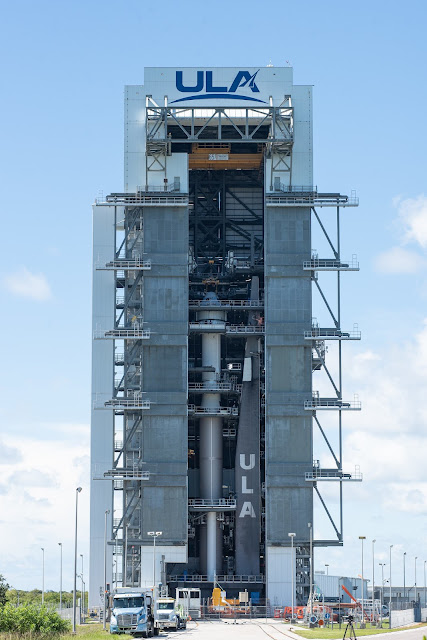Boeing / NASA - Starliner Orbital Flight Test-2 (OFT-2) patch.
May 16, 2022
NASA and Boeing are taking another major step on the path to regular human spaceflight to the International Space Station using American rockets to launch spacecraft from American soil with the second uncrewed test flight of a commercial crew spacecraft.
Image above: The Boeing CST-100 Starliner spacecraft is secured atop a United Launch Alliance Atlas V rocket at the Vertical Integration Facility at Space Launch Complex 41 at Cape Canaveral Space Force Station in Florida on July 17, 2021. Starliner will launch on the Atlas V for Boeing’s second Orbital Flight Test (OFT-2) for NASA’s Commercial Crew Program. The spacecraft rolled out from Boeing’s Commercial Crew and Cargo Processing Facility at NASA’s Kennedy Space Center earlier in the day. Images Credits: Boeing/John Grant.
NASA’s Boeing Orbital Flight Test-2 (OFT-2) is targeting launch of the CST-100 Starliner spacecraft on a United Launch Alliance Atlas V rocket at 6:54 p.m. EDT Thursday, May 19, from Space Launch Complex-41 on Cape Canaveral Space Force Station in Florida. Starliner is expected to arrive at the space station for docking about 24 hours later with more than 800 pounds of cargo, including about 500 pounds of NASA cargo and crew supplies.
OFT-2 will test the end-to-end capabilities of Starliner from launch to docking, atmospheric re-entry, and a desert landing in the western United States. OFT-2 will provide valuable data that will help NASA certify Boeing’s crew transportation system to carry astronauts to and from the space station.
Though no crew will be onboard the spacecraft for OFT-2, the Starliner commander’s seat will be occupied by Rosie the Rocketeer, the company’s anthropometric test device. During OFT-1, Rosie was outfitted with 15 sensors to collect data on what astronauts will experience during flights on Starliner. For OFT-2, spacecraft data capture ports previously connected to Rosie’s 15 sensors will be used to collect data from sensors placed along the seat pallet, which is the infrastructure that holds all the crew seats in place.
Image above: Boeing’s CST-100 Starliner spacecraft is secured atop a United Launch Alliance Atlas V rocket at the Vertical Integration Facility at Space Launch Complex-41 at Florida’s Cape Canaveral Space Force Station on July 17, 2021. Image Credits: Boeing/Damon Tucci.
During Starliner’s approach to the space station, NASA and Boeing will verify data links and command capabilities by the station crew, including a hold during approach commanded from the station by NASA astronaut Kjell Lindgren aboard station. Starliner also will demonstrate its ability to perform an automated retreat in the event an issue arises during approach.
Starliner’s vision-based navigation system will be tested as it autonomously docks with the space station about 7:10 p.m. Friday, May 20, or about 24 hours after launch.
After a successful docking, Starliner will spend five to 10 days aboard the orbiting laboratory before returning to Earth in the western United States. The spacecraft will return with nearly 600 pounds of cargo, including reusable Nitrogen Oxygen Recharge System tanks that provide breathable air to station crew members.
OFT-2 is the second orbital flight for the CST-100 Starliner, and the first for the second crew module in the Starliner fleet. Boeing is flying this second orbital test to prove the Starliner system meets NASA’s requirements, including docking to the space station.
OFT-2 will build on the mission objectives achieved during Starliner’s initial flight test, including:
- In-orbit operation of the avionics, docking system, communications and telemetry systems, environmental control systems, solar arrays and electrical power systems and propulsion systems;
- Performance of the guidance, navigation & control systems of the Starliner and Atlas V through ascent, on-orbit, and entry;
- Acoustic and vibration levels, and loads across the Starliner exterior and interior;
- Launch escape trigger monitoring; and Performance of the Starliner system end-to-end mission operations.
OFT-2 also will test the changes and improvements made to Starliner, and prove the system is ready to fly astronauts. NASA and Boeing engineers, technicians and flight control teams have all been working together to get Starliner back to space safely and efficiently for OFT-2. Following a successful flight test and subsequent data reviews, NASA and Boeing will set a target launch date for the Crew Flight Test (CFT) with astronauts on board.
CST-100 Starliner. Animation Credit: Boeing
NASA’s Commercial Crew Program has delivered on its goal of safe, reliable, and cost-effective transportation to and from the International Space Station from the United States through a partnership with American private industry. This partnership is changing the arc of human spaceflight history by opening access to low-Earth orbit and the space station to more people, more science, and more commercial opportunities. The space station remains the springboard to NASA's next great leap in space exploration, including future missions to the Moon and, eventually, to Mars.
Related article:
What You Need to Know about NASA’s Boeing Orbital Flight Test-2
https://orbiterchspacenews.blogspot.com/2021/07/what-you-need-to-know-about-nasas.html
Related links:
Commercial Crew: https://www.nasa.gov/exploration/commercial/crew/index.html
Kennedy Space Center (KSC): https://www.nasa.gov/centers/kennedy/home/index.html
International Space Station (ISS): https://www.nasa.gov/mission_pages/station/main/index.html
Images (mentioned), Animation (mentioned), Text, Credits: NASA/Danielle Sempsrott.
Greetings, Orbiter.ch




